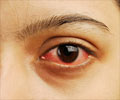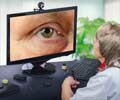Telemedicine was found to be effective than in-person eye exams in treating a rare, but devastating cause of blindness in premature babies.

The study's first authors are Hilal Biten, M.D., and Travis Redd, M.D., M.P.H. Redd is an OHSU ophthalmology resident and Biten was a visiting OHSU scholar who now works at Ankara Numun Training and Research Hospital in Turkey. Retinopathy of prematurity is caused by abnormal blood vessel growth near the retina, the light-sensitive portion in the back of an eye. The National Eye Institute of the National Institutes of Health reports that while up to 16,000 U.S. babies experience the condition to some degree, only 400 to 600 become legally blind each year as a result.
Some U.S. medical associations recommend an in-person exam, which involves a special magnifying device that shines light into a baby's dilated eye, to diagnose the condition. But trained professionals aren't always easy to find in rural areas and developing countries. The research team compared the accuracy of in-person exams with digital eye images that were remotely evaluated by professionals. They partnered with seven medical institutions to examine the eyes of 281 infants who were at risk for the condition. Each eye was evaluated both in-person and remotely with a wide-angle telemedicine image.
The researchers found there was no difference in the overall accuracy between the two evaluation methods. In-person examiners were found to be slightly better at accurately diagnosing the condition's later-stage development, but the research team concluded telemedicine could be used to diagnose clinically significant cases of retinopathy of prematurity.
Source-Eurekalert













